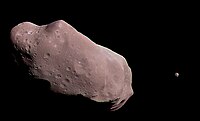
Photo from wikipedia
Abstract The type C asteroid Ryugu has been visited by the JAXA Hayabusa2 mission, a first for a primitive asteroid in the Solar System exploration. Samples have been collected at… Click to show full abstract
Abstract The type C asteroid Ryugu has been visited by the JAXA Hayabusa2 mission, a first for a primitive asteroid in the Solar System exploration. Samples have been collected at its surface by the spacecraft and are now on their way back to Earth. The surface of Ryugu has also been observed both in the visible and infrared wavelengths with the objective of characterizing its properties at a global scale. Here, we report on the albedo and spectro-photometric properties of Ryugu as derived from the NIRS3 IR spectrometer. Thanks to an innovative technique based on a Bayesian approach, we retrieved the Hapke photometric parameters from multi-geometric NIRS3 observations over the NIR spectral range and different areas of Ryugu, including the first collection site. Results reveal an overall spatial homogeneity of the photometric parameters, though some small variations can be highlighted. A new photometric correction was derived and applied to NIRS3 data. Reflectance spatial heterogeneity was quantitatively investigated, in particular by deriving and mapping the single scattering albedo (SSA) at various spatial scales. This parameter could be derived with confidence on about one fourth of Ryugu’s surface, especially around the equatorial region and the southern middle latitudes. Although Ryugu is to first order homogenous with a typical SSA of 0.045–0.050, we demonstrate with a local-scale photometric correction (1) the presence of a large “bright” area between ∼ 19 0 ∘ E and ∼ 29 0 ∘ E longitude around the equator and the southern middle latitudes, and (2) the presence of darker areas with a clear connection to geomorphological features. We show here that these darker regions tend to have a slightly deeper 2 . 72 μ m feature, at least compared to the surrounding areas, which can be explained by an enrichment of the top-surface in dark fines coupled to hydrated phases. Some spatial variability observed in the coupling between the SSA at 1 . 89 μ m and the 2 . 72 μ m feature also suggests that Ryugu exhibits some (slight) heterogeneity in its building blocks.
Journal Title: Icarus
Year Published: 2021
Link to full text (if available)
Share on Social Media: Sign Up to like & get
recommendations!